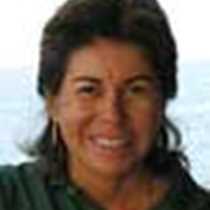Santa Cruz Island
We awoke along the northwestern coast of Santa Cruz, and early this morning we were blessed with a beautiful sunrise. After breakfast, we disembarked to explore a magical spot named Cerro Dragon that first opened for tourism in 1993.
The highlight of the day is a key species for the Galápagos: the land iguana. The name of this spot translates as Dragon Hill, and was so named because it is one of the few sites on Santa Cruz Island where a relatively healthy population of land iguanas was found prior to the mid sixties. This endemic reptile amazed us with its beautiful coloration: yellow and brown that is particularly bright in males, while females are smaller and darker.
Herbivorous and very timid, the land iguanas have now been protected since 1975, when the Charles Darwin Research Station started an important conservation program to save this population, which rapidly descended into a state of near-extinction due to predation by feral dogs.
Those who chose not to hike around the hill took a Zodiac cruise through the channels of the neighbouring Venecia Islets, where we found lots of surprises: white-tipped reef sharks, sting rays, blue-footed boobies, brown pelicans, lava herons and something very important: very happy explorers.
In the afternoon our adventure took us towards North Seymour Island, where we found several couples of blue-footed boobies in their mid-courtship dance. Male frigates were in courtship too, with their pouches expanded while trying to impress females flying overhead. Several frigate chicks were also seen with their parents.
The walk along the beach allowed us to observe more frigates in their nests , boobies dancing and doing their foot-raising, several marine iguanas basking in the sun and many sea lion puppies awaiting their mothers while gazing into the cameras of enthralled onlookers.
By the time we were leaving, Mother Nature gave us a remarkable sunset as a final present.
We awoke along the northwestern coast of Santa Cruz, and early this morning we were blessed with a beautiful sunrise. After breakfast, we disembarked to explore a magical spot named Cerro Dragon that first opened for tourism in 1993.
The highlight of the day is a key species for the Galápagos: the land iguana. The name of this spot translates as Dragon Hill, and was so named because it is one of the few sites on Santa Cruz Island where a relatively healthy population of land iguanas was found prior to the mid sixties. This endemic reptile amazed us with its beautiful coloration: yellow and brown that is particularly bright in males, while females are smaller and darker.
Herbivorous and very timid, the land iguanas have now been protected since 1975, when the Charles Darwin Research Station started an important conservation program to save this population, which rapidly descended into a state of near-extinction due to predation by feral dogs.
Those who chose not to hike around the hill took a Zodiac cruise through the channels of the neighbouring Venecia Islets, where we found lots of surprises: white-tipped reef sharks, sting rays, blue-footed boobies, brown pelicans, lava herons and something very important: very happy explorers.
In the afternoon our adventure took us towards North Seymour Island, where we found several couples of blue-footed boobies in their mid-courtship dance. Male frigates were in courtship too, with their pouches expanded while trying to impress females flying overhead. Several frigate chicks were also seen with their parents.
The walk along the beach allowed us to observe more frigates in their nests , boobies dancing and doing their foot-raising, several marine iguanas basking in the sun and many sea lion puppies awaiting their mothers while gazing into the cameras of enthralled onlookers.
By the time we were leaving, Mother Nature gave us a remarkable sunset as a final present.




